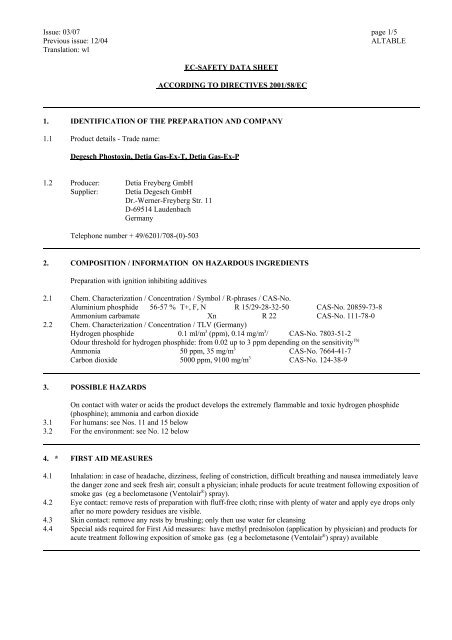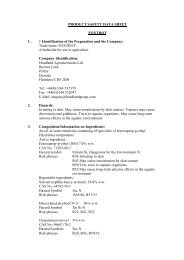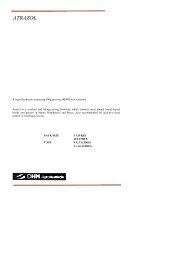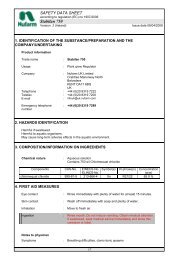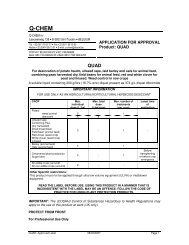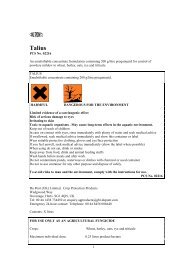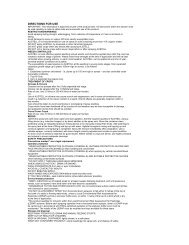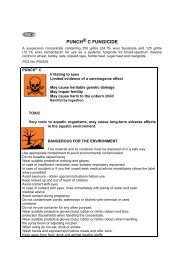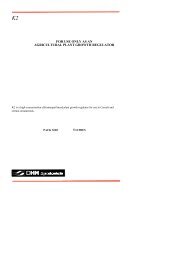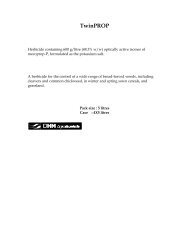Create successful ePaper yourself
Turn your PDF publications into a flip-book with our unique Google optimized e-Paper software.
Issue: 03/07 page 1/5<br />
Previous issue: 12/04<br />
ALTABLE<br />
Translation: wl<br />
EC-SAFETY DATA SHEET<br />
ACCORDING TO DIRECTIVES 2001/58/EC<br />
1. IDENTIFICATION OF THE PREPARATION AND COMPANY<br />
1.1 Product details - Trade name:<br />
Degesch Phostoxin, Detia Gas-Ex-T, Detia Gas-Ex-P<br />
1.2 Producer: Detia Freyberg GmbH<br />
Suppl<strong>ie</strong>r: Detia Degesch GmbH<br />
Dr.-Werner-Freyberg Str. 11<br />
D-69514 Laudenbach<br />
Germany<br />
Telephone number + 49/6201/708-(0)-503<br />
2. COMPOSITION / INFORMATION ON HAZARDOUS INGREDIENTS<br />
Preparation with ignition inhibiting additives<br />
2.1 Chem. Characterization / Concentration / Symbol / R-phrases / CAS-No.<br />
Aluminium phosphide 56-57 % T+, F, N R 15/29-28-32-50 CAS-No. 20859-73-8<br />
Ammonium carbamate Xn R 22 CAS-No. 111-78-0<br />
2.2 Chem. Characterization / Concentration / TLV (Germany)<br />
Hydrogen phosphide 0.1 ml/m 3 (ppm), 0.14 mg/m 3 / CAS-No. 7803-51-2<br />
Odour threshold for hydrogen phosphide: from 0.02 up to 3 ppm depending on the sensitivity 1b)<br />
Ammonia 50 ppm, 35 mg/m 3 CAS-No. 7664-41-7<br />
Carbon dioxide 5000 ppm, 9100 mg/m 3 CAS-No. 124-38-9<br />
3. POSSIBLE HAZARDS<br />
On contact with water or acids the product develops the extremely flammable and toxic hydrogen phosphide<br />
(phosphine); ammonia and carbon dioxide<br />
3.1 For humans: see Nos. 11 and 15 below<br />
3.2 For the environment: see No. 12 below<br />
4. * FIRST AID MEASURES<br />
4.1 Inhalation: in case of headache, dizziness, feeling of constriction, difficult breathing and nausea immediately leave<br />
the danger zone and seek fresh air; consult a physician; inhale products for acute treatment following exposition of<br />
smoke gas (eg a beclometasone (Ventolair ® ) spray).<br />
4.2 Eye contact: remove rests of preparation with fluff-free cloth; rinse with plenty of water and apply eye drops only<br />
after no more powdery residues are visible.<br />
4.3 Skin contact: remove any rests by brushing; only then use water for cleansing<br />
4.4 Special aids required for First Aid measures: have methyl prednisolon (application by physician) and products for<br />
acute treatment following exposition of smoke gas (eg a beclometasone (Ventolair ® ) spray) available
EC SAFETY DATA SHEET Degesch Phostoxin, Detia Gas-Ex-T, Detia Gas-Ex-P Issue 03/07 page 2/5<br />
5. FIRE-FIGHTING MEASURES<br />
5.1 Suitable extinguishing media: the product itself does not burn; extinguish fires in the vicinity with dry sand or<br />
powder and than with CO 2<br />
5.2 Extinguishing media that must not be used for safety reasons: water, extinguishers containing water<br />
5.3 Special hazards from the substance itself, its combustion products or from its vapours: in case of fires hazardous<br />
combustion gases are formed: caustic phosphoric acid aerosols (phosphoric pentoxide)<br />
5.4 Special protective equipment for firefighting: respiratory equipment, see No. 8.1 below<br />
6. ACCIDENTAL RELEASE MEASURES<br />
See Nos. 8 and 13 below<br />
6.1 Person-related precaution measures: leave danger zone immediately; see No. 8 below<br />
6.2 Environment protection measures: n.a.<br />
6.3 Methods for cleaning up / taking up: n.a.<br />
7. HANDLING AND STORAGE<br />
7.1 Handling<br />
7.1.1 Advice on safe handling: follow regulations for the handling of dangerous goods<br />
7.2 Storage<br />
7.2.1 Demands upon storerooms and containers: see No. 7.1.1<br />
7.2.2 Further information on storage conditions:<br />
Obviate contact with water, acids and amb<strong>ie</strong>nt humidity<br />
8. EXPOSURE CONTROLS / PERSONAL PROTECTION<br />
see also No. 2.2: TLV<br />
8.1 Respiratory protection: respiratory equipment suitable for hydrogen phosphide, filter B, colour grey<br />
8.2 Hand protection: suitable gloves<br />
8.3 Eye protection: n.a.<br />
8.4 Body protection: suitable protective clothing
EC SAFETY DATA SHEET Degesch Phostoxin, Detia Gas-Ex-T, Detia Gas-Ex-P Issue 03/07 page 3/5<br />
9. * PHYSICAL AND CHEMICAL PROPERTIES<br />
9.1 Appearance:<br />
9.1.1 Form: under the influcence of amb<strong>ie</strong>nt air the solid products develop gaseous phosphine<br />
9.1.2 Colour: greyish-green<br />
9.1.3 Odour: garlic or carbide-like<br />
9.2 pH-value (20 !C): n.a.<br />
9.3 Boiling point / range (in !C): n.a.<br />
9.4 Melting point / range (in !C): aluminium phosphide > 500 !C 11)<br />
9.5 Data relevant to safety:<br />
9.5.1 Flash point in °C: n.a.<br />
9.5.2 Inflammability: in contact with water / humidity, acids an extremely flammable gas is developed<br />
9.5.3 Selfignition: contains additives to prevent self-ignition<br />
9.5.4 Fire enhancing propert<strong>ie</strong>s: n.a.<br />
9.6 Explosion danger in vol%:<br />
9.6.1 Lower explosion limit: hydrogen phosphide 1.8 1a) (1.79-1.89)<br />
9.6.2 Upper explosion limit: n.v.<br />
9.7 Further information<br />
9.7.1 Vapour pressure: hydrogen phosphide 34.6 bar (20!C) 9)<br />
9.7.2 Relative density: n.a.<br />
9.7.3 Settled appearance density: (powder) 0.95 g/cm³<br />
9.8 General solubility:<br />
9.8.1 Solubility in water: not applicable due to decomposition<br />
9.8.2 Liposolubility/solvent: n.t.<br />
9.8.3 Distribution coeffic<strong>ie</strong>nt (n-octanol/water): n.a.<br />
10. STABILITY AND REACTIVITY<br />
10.1 Conditions to be avoided: see No. 7 above<br />
10.2 Substances to be avoided: water and acids cause aluminium phosphide to decompose in a violent reaction into<br />
extremely flammable and toxic hydrogen phosphide<br />
10.3 Hazardous decomposition products: hydrogen phosphide, phosphoric pentoxide, phosphoric acid (No. 5.3)<br />
10.4 Further information:<br />
10.4.1 Stabilizors available: yes<br />
10.4.2 Change of aggregation condition: Influence on safety: uncontrolled development of hydrogen phosphide can cause<br />
fires<br />
11. TOXICOLOGICAL DATA<br />
11.1 Acute toxicity:<br />
11.1.1 Swallowing, LD 50 rat oral (mg/kg): aluminium phosphide: 8.7 2) Phostoxin: 11.5 3)<br />
11.1.2 Inhalation, LC 50 rat inhalative (4hrs.): hydrogen phosphide 11 ppm = 0.015 mg/l 4)<br />
11.1.3 Skin contact, LD 50 rat dermal (mg/kg): n.v.<br />
11.1.4 Eye contact: n.v.<br />
11.2 Chronical effect: none known<br />
11.2.1 Sensitizing effect: Gas-Ex-T: no skin sensitization 10)<br />
11.2.2 Carcinogenic effect: -<br />
11.2.3 Genotype variating effect: -<br />
11.2.4 Reproduction endangering effect: -<br />
11.2.5 Anaesthetizing effect: -<br />
11.3 Other information: inhalation and ingestion of large quantit<strong>ie</strong>s may lead to very serious poisoning. Highly<br />
dangerous after 1/2 to 1 hour are already 400-600 mg/m 3 =290-430 ppm phosphine 1c)<br />
IDLH (Immediately Dangerous to Life and Health) = 282 mg/m 3 = 200 ppm phosphine (US EPA,1985) 5)
EC SAFETY DATA SHEET Degesch Phostoxin, Detia Gas-Ex-T, Detia Gas-Ex-P Issue 03/07 page 4/5<br />
12. ECOLOGICAL INFORMATION<br />
12.1 Ability to decompose: n.a.<br />
12.2 Reaction in sewerage plants: n.a.<br />
12.3 Aqueous toxicity: LC 50 (rainbow trout, 96 hrs.) = 9.7 x 10 -3 ppm 6)<br />
EC 50 (daphnia magna, 24 hrs.) = 0.2 mg/l 7)<br />
12.4 Ecotoxicity: phosphine decomposes in the atmosphere within 5 - 28 hours 8)<br />
13. DISPOSAL CONSIDERATIONS<br />
13.1 For substance / preparation / residues: product: waste code #: 061301<br />
13.2 Recommendation: degassed material should be disposed of under observation of the prevailing regulations<br />
(waste code #: 060316)<br />
14. * TRANSPORT INFORMATION<br />
14.1 Road-/rail transport acc. to ADR/RID:<br />
14.1.1 class: 4.3, UN 1397, PG: I<br />
14.1.2 Description of goods: Aluminium phosphide<br />
14.1.3 Labels: Dangerous when wet 4 = main risk<br />
Toxic = subsidiary risk<br />
14.1.4 Red (warning) board: starting 20 kgs net weight<br />
14.1.5 Remarks: limited quantit<strong>ie</strong>s acc. to chapter 3.4 not possible<br />
14.2 Sea transport acc. to IMDG-Code<br />
14.2.1 class: 4.3 UN-No.: 1397 Packing Group I<br />
14.2.2 Proper shipping name: ALUMINIUM PHOSPHIDE<br />
14.2.3 Labels: Dangerous when wet 4 = main risk<br />
Toxic = subsidiary risk<br />
Marine pollutant: no<br />
14.2.4 EmS-Code: F-G, S-N<br />
14.3 Air transport acc. to IATA-DGR/ICAO-TI<br />
14.3.1 See sea transport and packaging instructions: 412<br />
14.3.2 Proper shipping name: Aluminium phosphide<br />
14.3.3 See sea transport<br />
14.3.4 Remarks: max. weight 1 kg/inner packaging, 15 kg/outer packaging cargo aircraft only<br />
14.4 Transport by barge acc. to ADN/ADNR see road transport<br />
15. REGULATIONS<br />
Labelling according to German Regulations concerning dangerous Goods including EC regulations<br />
(including Directive 1999/45/EC**)<br />
15.1 Symbol: F, T+, N**<br />
15.2 Hazard description: highly flammable, very toxic, dangerous for the environment**<br />
15.3 R-phrases: 15/29 - Contact with water liberates toxic, extremely flammable gas.<br />
26/28 - Very toxic by inhalation and if swallowed.<br />
32 - Contact with acids liberates very toxic gas<br />
50** - Very toxic to aquatic organisms.<br />
15.4 S-phrases: 1/2 - Keep locked up and out of the reach of children.<br />
3/9/49 - Keep only in the original container in a cool well-ventilated place.<br />
7/8 - Keep container tightly closed and dry.<br />
13 - Keep away from food, drink and animal feedingstuffs.<br />
20/21 - When using do not eat, drink or smoke.<br />
22 - Do not breathe dust.<br />
30 - Never add water to this product.<br />
43 - In case of fire, use dry sand, powder or CO 2 . Never use water.<br />
45 - In case of accident or if you feel unwell, seek medical advice immediately (show the<br />
label<br />
where possible).<br />
61** - Avoid release to the environment. Refer to special instructions/safety data sheets.<br />
15.5 Additional: empty packaging must not be reused
EC SAFETY DATA SHEET Degesch Phostoxin, Detia Gas-Ex-T, Detia Gas-Ex-P Issue 03/07 page 5/5<br />
16. ADDITIONAL INFORMATION<br />
LEGEND:<br />
* = changes from previous version<br />
** = Classification/labelling according to Directive 1999/45/EC have to be appl<strong>ie</strong>d for preparations within the scope<br />
of<br />
Directive 91/414/EEC (plant protection products) or Directive 98/8/EC (biocides) as from 30 July 2004.<br />
n.a. = not applicable<br />
n.t. = not tested<br />
n.v. = not available<br />
TLV = Threshold Limit Value<br />
REFERENCES:<br />
1) WHO Environmental Health Criteria 73: Phosphine and Selected Metal Phosphides: a) page 18, b) page 72, c)<br />
page 75<br />
2) International Bio-Research Inc., D-Hannover: Acute oral toxicity of Aluminium phosphide in rats (1.1.1977)<br />
3) Hazleton Laborator<strong>ie</strong>s America, Inc.: Acute oral toxicity study in rats of Degesch Phostoxin formulation<br />
(1.12.1983)<br />
4) Waritz, R.S. & Brown, R.M. (1975): Acute and subacute inhalation toxicit<strong>ie</strong>s of phosphine, phenylphosphine and<br />
triphenylphosphine; Am. Ind. Assoc. J., 36: 452-458.<br />
5) US Environmental Protection Agency: EPA chemical profile: Phosphine, Washington DC, 1985<br />
6) Laboratory for Pharmacology and Toxicology, D-Hamburg: Prüfung der akuten Toxizität von Aluminiumphosphid<br />
an Regenbogenforellen (24.11.1984)<br />
7) Ökolimna, D-Burgwedel: Daphn<strong>ie</strong>ntoxizitätstest mit Aluminiumphosphid, 1986<br />
8) Frank, R.; Rippen, G.: Verhalten von Phosphin in der Atmosphäre, Lebensmitteltechnik Juli/August 1987<br />
9) Drägerwerk AG: Dräger-Röhrchen-Handbuch: Boden-, Wasser- und Luftuntersuchungen sow<strong>ie</strong> technische<br />
Gasanalyse, Lübeck, 1993<br />
10) Bioagri Laboratórios Ltda.: Evaluation of skin sensitization of test substance DETIA GAS-EX-T-PASTILHAS<br />
DE 3g (27.07.2004)<br />
11) S<strong>ie</strong>mens Axiva GmbH & Co. KG, D-Frankfurt am Main: Aluminium phosphide technical: Melting point, boiling<br />
point, vapour pressure (09.07.2002)<br />
The above information is based on our present state of knowledge. It describes the product with respect to the safety<br />
measures required and should not therefore be construed as guaranteeing specific propert<strong>ie</strong>s nor must it be altered or<br />
transferred to other products.
Brian Poyntz Wednesday, 24 June 2009 10:25<br />
Subject: AW: Safety Data Sheets<br />
Date: Wednesday, 24 June 2009 10:06<br />
From: Engel Günter <br />
To: Brian Poyntz <br />
Cc: Pfromm Hartmut <br />
Dear Brian,<br />
The MSDS for DETIA GAS - EX - T, P and EX - B Forte are unchanged, i.e. the<br />
2007 version is still valid.<br />
Best regards Guenter Engel DETIA DEGESCH GMBH<br />
Page 1 of 1


